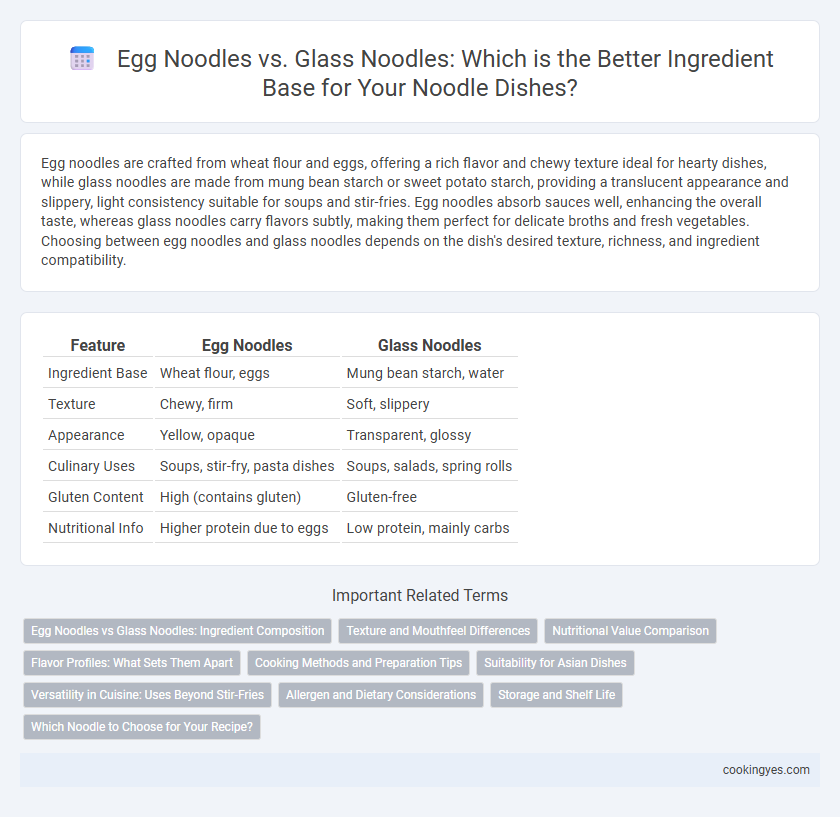Egg noodles are crafted from wheat flour and eggs, offering a rich flavor and chewy texture ideal for hearty dishes, while glass noodles are made from mung bean starch or sweet potato starch, providing a translucent appearance and slippery, light consistency suitable for soups and stir-fries. Egg noodles absorb sauces well, enhancing the overall taste, whereas glass noodles carry flavors subtly, making them perfect for delicate broths and fresh vegetables. Choosing between egg noodles and glass noodles depends on the dish's desired texture, richness, and ingredient compatibility.
Table of Comparison
| Feature | Egg Noodles | Glass Noodles |
|---|---|---|
| Ingredient Base | Wheat flour, eggs | Mung bean starch, water |
| Texture | Chewy, firm | Soft, slippery |
| Appearance | Yellow, opaque | Transparent, glossy |
| Culinary Uses | Soups, stir-fry, pasta dishes | Soups, salads, spring rolls |
| Gluten Content | High (contains gluten) | Gluten-free |
| Nutritional Info | Higher protein due to eggs | Low protein, mainly carbs |
Egg Noodles vs Glass Noodles: Ingredient Composition
Egg noodles primarily consist of wheat flour, eggs, salt, and water, providing a rich, chewy texture and high protein content due to the eggs. Glass noodles, made from mung bean starch or sweet potato starch and water, are gluten-free and have a translucent, slippery texture when cooked. The primary distinction in ingredient composition influences their nutritional profile, texture, and suitability for different culinary applications.
Texture and Mouthfeel Differences
Egg noodles are characterized by their firm yet tender texture, offering a slightly chewy mouthfeel that holds up well in stir-fries and soups. Glass noodles, made from mung bean starch, provide a translucent appearance and a slippery, smooth texture that becomes soft and slightly elastic when cooked. The contrast between the hearty bite of egg noodles and the delicate, gelatinous quality of glass noodles makes them suitable for distinct culinary applications based on desired texture and mouthfeel.
Nutritional Value Comparison
Egg noodles contain higher protein and fat content due to eggs, providing essential amino acids and energy, while glass noodles are lower in calories and fat, ideal for low-calorie diets. Glass noodles, made from mung bean or sweet potato starch, offer gluten-free advantages but lack significant protein or fiber. Egg noodles supply more vitamins such as B12 and iron, supporting muscle health and oxygen transport, whereas glass noodles emphasize hydration and easy digestion.
Flavor Profiles: What Sets Them Apart
Egg noodles offer a rich, savory flavor with a slightly chewy texture due to the presence of wheat and egg, making them ideal for hearty dishes and broths. Glass noodles, made from mung bean starch or sweet potato starch, provide a neutral, subtly sweet taste and a slippery, translucent appearance that absorbs surrounding flavors easily. The distinct texture and flavor profiles of egg and glass noodles create unique culinary experiences suited to different regional recipes and cooking methods.
Cooking Methods and Preparation Tips
Egg noodles, made from wheat flour and eggs, are best boiled or stir-fried, absorbing flavors well and offering a chewy texture; parboil them briefly to avoid overcooking. Glass noodles, derived from mung bean or sweet potato starch, require soaking in warm water before a quick stir-fry or boiling, turning translucent and silky when cooked. Using the right cooking method enhances the noodles' texture and flavor absorption, essential for dishes like pad thai or soups.
Suitability for Asian Dishes
Egg noodles provide a rich, chewy texture ideal for stir-fries, soups, and lo mein, enhancing traditional Asian dishes with their wheat-based composition and egg protein content. Glass noodles, made from mung bean starch, offer a translucent, slippery consistency that excels in hot pots, spring rolls, and cold salads, complementing flavors without overpowering them. Both noodles suit different Asian culinary applications; egg noodles bring robustness to hearty meals, while glass noodles contribute a light, delicate element to more subtle dishes.
Versatility in Cuisine: Uses Beyond Stir-Fries
Egg noodles provide a rich, chewy texture ideal for hearty soups, casseroles, and baked dishes, making them a staple in Eastern European and Asian cuisines. Glass noodles, made from mung bean starch, offer a translucent, slippery consistency perfect for salads, spring rolls, and hot pots, broadening their use beyond stir-fries. Both noodles adapt well to diverse global recipes, enhancing dishes with unique textures and flavors that extend culinary possibilities.
Allergen and Dietary Considerations
Egg noodles contain wheat and eggs, which are common allergens and unsuitable for individuals with gluten intolerance or egg allergies, while glass noodles are typically made from mung bean starch or sweet potato starch and are gluten-free, making them a safer option for those with celiac disease or gluten sensitivity. Glass noodles are also vegan and calorie-friendly, whereas egg noodles provide more protein but may not fit plant-based diets. Selecting between these noodles depends on dietary restrictions, allergen concerns, and nutritional preferences.
Storage and Shelf Life
Egg noodles, made from wheat flour and eggs, require refrigeration and typically have a shelf life of 1 to 2 weeks when stored properly. Glass noodles, composed mainly of mung bean starch or sweet potato starch, are shelf-stable and can be stored in a cool, dry pantry for up to 2 years without refrigeration. Proper storage conditions, such as airtight containers for glass noodles and sealed packaging for egg noodles, are essential to maintain freshness and prevent spoilage.
Which Noodle to Choose for Your Recipe?
Egg noodles, made from wheat flour and eggs, offer a rich flavor and firm texture ideal for hearty dishes like stir-fries and soups, providing a substantial bite and absorbing sauces well. Glass noodles, crafted from mung bean or sweet potato starch, are translucent, lightweight, and gluten-free, making them perfect for light, refreshing dishes or salads that require a delicate texture. Choosing between egg noodles and glass noodles depends on the desired dish's texture, flavor profile, and dietary restrictions, with egg noodles suited for robust meals and glass noodles for lighter, gluten-free options.
Egg noodles vs Glass noodles for ingredient base Infographic

 cookingyes.com
cookingyes.com